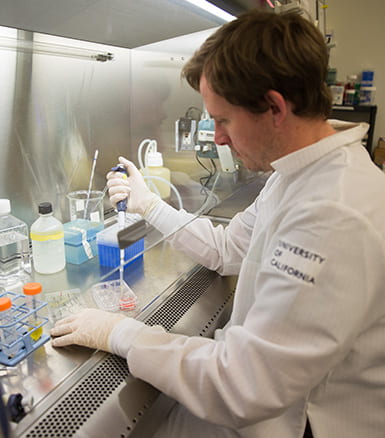New genes arose in human ancestors just before a dramatic increase in brain size and are involved in genetic defects associated with neurological disorders
May 31, 2018
By Tim Stephens | UCSC
A set of three nearly identical genes found only in humans appear to play a critical role in the development of our large brains, according to a study led by researchers at UC Santa Cruz.
The genes appeared between 3 and 4 million years ago, just before the period when fossils show a dramatic increase in the brain sizes of human ancestors. In modern humans, the genes are involved in genetic defects associated with neurological disorders.
Published May 31 in Cell, the study represents more than five years of work to characterize the genes, their role in neurological development, and their evolutionary origins. They belong to an ancient family of genes known as Notch genes, first discovered in fruit flies and named for a genetic defect causing notched wings.
“This is a family of genes that goes back hundreds of millions of years in evolutionary history and is known to play important roles in embryonic development. To find that humans have a new member of this family that is involved in brain development is extremely exciting,” said senior author David Haussler, professor of biomolecular engineering and scientific director of the UC Santa Cruz Genomics Institute.
Genetic defects
The site of the genes on the long arm of chromosome 1 is involved in genetic defects in which large segments of DNA are either duplicated or deleted, leading to neurological disorders known collectively as 1q21.1 deletion/duplication syndrome. Deletions are often associated with microcephaly (abnormally small head size) and autism, while duplications are often associated with macrocephaly (abnormally large head size) and schizophrenia.
The new human-specific Notch genes were derived from NOTCH2, one of four previously known mammalian Notch genes, through a duplication event that inserted an extra partial copy of NOTCH2 into the genome. This happened in an ancient ape species that was a common ancestor of humans, chimpanzees, and gorillas. The partial duplicate was a nonfunctional “pseudogene,” versions of which are still found in chimp and gorilla genomes. In the human lineage, however, this pseudogene was “revived” when additional NOTCH2 DNA was copied into its place, creating a functional gene. This new gene was then duplicated several more times, resulting in four related genes, called NOTCH2NL genes, found only in humans.
One of the four NOTCH2NL genes appears to be a nonfunctional pseudogene, but the other three (NOTCH2NLA, NOTCH2NLB, and NOTCH2NLC) are active genes that direct the production of truncated versions of the original NOTCH2 protein. Notch proteins are involved in signaling between and within cells. In many cases, the Notch signaling pathway regulates the differentiation of stem cells in developing organs throughout the body, telling stem cells when to become, for example, mature heart cells or neurons.
“Notch signaling was already known to be important in the developing nervous system,” said senior author Sofie Salama, a research scientist at UC Santa Cruz. “NOTCH2NL seems to amplify Notch signaling, which leads to increased proliferation of neural stem cells and delayed neural maturation.”
[ Read more ]


Recent Comments